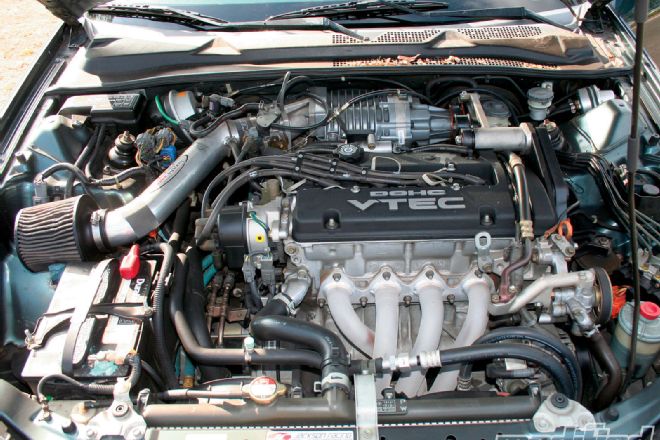While discussing Project RX-8 and some of our planned modifications with Jim Langer from Racing Beat, we got into an interesting discussion about the use of high-flow catalytic converters on the street and what constitutes a street-legal setup in California and elsewhere in the country. This led to a related discussion about CARB (California Air Resources Board), the EPA and what it takes to have an emissions-related performance part achieve street-legal status in California and across the United States, some of the highlights of which I'd like to share with you now.
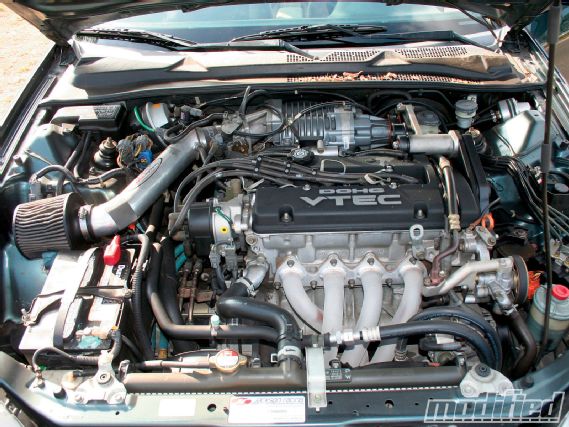 |
Putting Your Car On A CARB Diet - Tech Talk
|
Putting Your Car On A CARB Diet - Tech Talk
If you live in California, chances are you're aware that CARB requiresperformance parts manufacturers who want to sell their emissions-related products for legal on-road use in California and the five other states that have adopted CARB standards (New York, New Jersey, Massachusetts, Maine and Vermont) to obtain "emissions exemptions" for these parts. This applies to any part that might negatively impact tailpipe emissions, so everything from the catalytic converter forward that might alter the combustion process is in play. This includes parts like the air intake system, ignition system, exhaust manifold and, of course, the catalytic converter(s) - it also includes the addition of aftermarket turbocharger and supercharger kits.
By successfully completing the CARB exemption process, products are assigned an Executive Order or EO number. In non-CARB states, it's the EPA that sets emissions requirements for performance parts that impact on tailpipe emissions, but generally speaking, if a part is CARB legal it's also EPA legal since CARB standards are the strictest in the country. However, the rules in your state or even your part of the state may not require CARB exemption for emissions-related modifications, so it's important to do your homework and know what the requirements are in your area. Basically, it's in the more densely populated areas that air quality and therefore engine emissions are of greater concern, but if you live in a rural (or semi-rural) area or even a small city in a less densely populated state, CARB and EPA emissions may not apply.
 |
Some turbo and supercharger kits have passed the CARB exemption process, making them street legal in California and just about anywhere else in North America.
|
Some turbo and supercharger kits have passed the CARB exemption process, making them street legal in California and just about anywhere else in North America.
From a consumer standpoint in California and the other five CARB states, installing emissions-related performance parts that don't have a CARB exempt sticker on them comes with the risk of fines if Johnny Law pulls you over and spots that high-flow cat or non-exempt intake tube. Non-CARB exempt parts could also result in a failed Inspection and Maintenance (I&M) test, where the technician is meant to check for CARB stickers displaying the EO number for any aftermarket parts he spots. In California, a non-exempt component that's spotted on a vehicle during the required biannual tailpipe emissions will cause the vehicle to fail the initial visual inspection portion of the test - with the actual tailpipe sniffer test never being undertaken! Selling a car with non-CARB certified performance parts on it could also present a problem when attempting to register it or transfer its title, though you can get around this by returning the car to stock before selling it.
From a specialty/performance parts manufacturer standpoint, the CARB exemption process is even more complicated. As Jim Langer from Racing Beat explained, there are actually three different emissions standards to consider: 1) federal new car emissions standards, 2) CARB/EPA exemption testing, and 3) tailpipe smog checks. As Jim pointed out to us, CARB exemption tests are significantly different than tailpipe emissions tests, meaning it's much more difficult to produce an aftermarket performance part that meets CARB standards than it is to make one that'll pass a tailpipe emissions test. As Jim explained, "The CARB required test collects emissions samples beginning at engine start-up and continues through a 20-minute sequence of test cycles, each collecting and analyzing emission gases from each cycle. One of the most critical phases of the test is the initial cycle, which collects and measures exhaust gas from the first 505 seconds of the run cycle. This cycle measures air quality during the cold-start period before cat light off - typically the make-or-break portion of the test. Using established baselines, they then determine if your aftermarket component has a negative impact on these conditions. Other determining variables that are incorporated into the tests can be deterioration factors, aggressive driving cycles, A/C tests and a few others to make the actual testing representative of more real-world driving conditions; therefore making the testing more stringent."
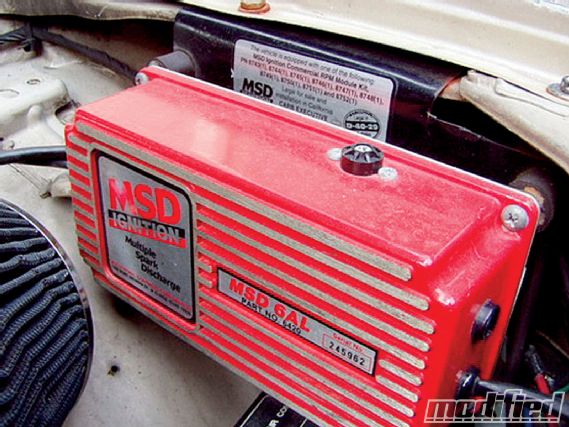 |
Putting Your Car On A CARB Diet - Tech Talk
|
Putting Your Car On A CARB Diet - Tech Talk
It's also extremely time-consuming and expensive to get a part to pass the CARB exemption process. Each test costs $2,000-$3,000, and retesting costs the same. Since it's not unusual for a performance part to fail CARB testing on the first try, it's easy to see how the costs, both in terms of R&D and money, can start to pile up. For a small specialty parts manufacturer, it's often prohibitively expensive to go through the CARB exemption process for a part they may only sell a few hundred examples of. So in a lot of cases, when you see that "for off-road use only" disclaimer on a manufacturer's website or product packaging, it's more an indication of it being a smaller volume product and therefore not a good investment for the company in terms of getting a CARB sticker for it, rather than it necessarily being an unfriendly product with respect to tailpipe emissions.
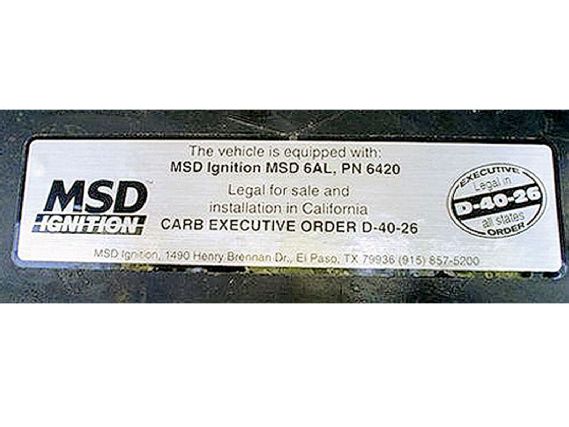 |
Even for bigger companies like MSD and K&N, the CARB exemption process is no cakewalk, while many of the smaller and less CARB-savvy specialty parts makers find it to be prohibitively expensive.
|
Even for bigger companies like MSD and K&N, the CARB exemption process is no cakewalk, while many of the smaller and less CARB-savvy specialty parts makers find it to be prohibitively expensive.
Making matters even more difficult for the manufacturers of emissions-related aftermarket performance parts, CARB issues an EO number that's specific to the vehicle make and model the product is designed for. So for companies like K&N and AEM, whose intake systems are often very similar in design for a wide range of vehicles, they must go through the CARB exemption process for every vehicle they want to establish a CARB exemption for. Ouch. For products like supercharger kits or turbo kits, this is less of a problem since these tend to be much more targeted products developed for a small number of very popular enthusiast-oriented vehicles, but the "aggressive driving cycle" CARB recently introduced, where the car accelerates while being driven on the test dyno to simulate more real-world driving conditions (unlike the steady-state testing that was required in years past) is making it much more difficult for aftermarket forced induction kits to achieve exempt status.
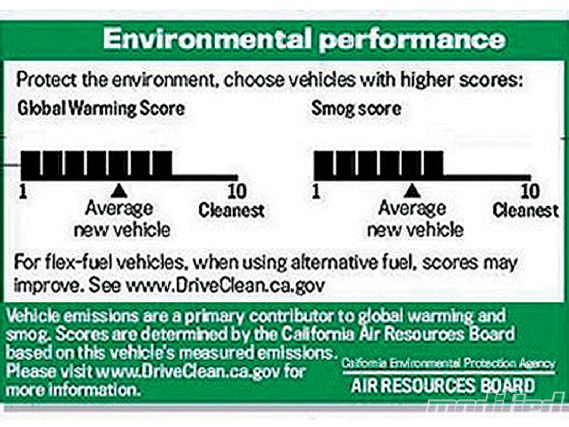 |
This "green" sticker you'll find on any vehicle sold in California after January 1, 2009, is meant to educate consumers about the environmental-friendliness of their car and motivate carmakers with below average sticker ratings to clean up their act.
EXEMPT
NON-EXEMPT
(CATEGORY I, ITEMS NOT OF CONCERN)
(CATEGORY III, PARTS REQUIRING CARB EO NUMBER)
Non-thermostatically charged air cleaners and/or
Thermostatically controlled air cleaner modifications
elements
Air conditioner cut-out systems
Airflow sensor modifications
Anti-theft systems
Aftermarket catalytic converters
Blow-by oil separators and filters
Carburetors not marketed as "emission replacements"
Electronic ignition systems retrofitted to vehicles
Distributor modifications
originally equipped with points, as long as the original
advance controls are maintained
Engine shut-off system
EGR system modifications
Governors
Electronic control units (including PROMs)
Ignition bridges and coil modifications
Electronic ignition system modifications
Throttle lockout systems
Engine conversions
Intercoolers for OEM turbochargers
Exhaust headers, crossover pipes, heat risers, particulate
traps and intake manifolds (not in Category I or II)
Under-carburetor screens
Fuel injection systems/modifications
Vapor/steam/water injectors
Superchargers
Turbochargers and turbocharger modifications
Nitrous Oxide systems
|
This "green" sticker you'll find on any vehicle sold in California after January 1, 2009, is meant to educate consumers about the environmental-friendliness of their car and motivate carmakers with below average sticker ratings to clean up their act.
EXEMPT
NON-EXEMPT
(CATEGORY I, ITEMS NOT OF CONCERN)
(CATEGORY III, PARTS REQUIRING CARB EO NUMBER)
Non-thermostatically charged air cleaners and/or
Thermostatically controlled air cleaner modifications
elements
Air conditioner cut-out systems
Airflow sensor modifications
Anti-theft systems
Aftermarket catalytic converters
Blow-by oil separators and filters
Carburetors not marketed as "emission replacements"
Electronic ignition systems retrofitted to vehicles
Distributor modifications
originally equipped with points, as long as the original
advance controls are maintained
Engine shut-off system
EGR system modifications
Governors
Electronic control units (including PROMs)
Ignition bridges and coil modifications
Electronic ignition system modifications
Throttle lockout systems
Engine conversions
Intercoolers for OEM turbochargers
Exhaust headers, crossover pipes, heat risers, particulate
traps and intake manifolds (not in Category I or II)
Under-carburetor screens
Fuel injection systems/modifications
Vapor/steam/water injectors
Superchargers
Turbochargers and turbocharger modifications
Nitrous Oxide systems

